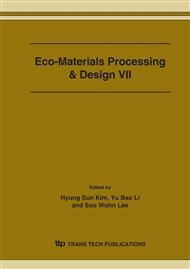p.882
p.886
p.890
p.894
p.898
p.902
p.906
p.910
p.914
Influences of the Crystallization Behavior of n-HA Reinforced PA66 Biocomposite on Its Mechanical Properties
Abstract:
The crystallization behavior of n-HA/PA66 biocomposites at different processing pressure and annealing temperature were investigated by XRD and DSC. The results showed that increasing annealing temperature would weaken the crystalline intensities of pure PA66 and its composites. For n-HA/PA66 composites, the peaks of α1 crystals of PA66 disappeared, only α2 crystals existed, and with the increase of injection pressure and annealing temperature, the crystalline intensity of PA66 decreased. The degree of crystallinity (Xc) of PA66 in composites increased with the increase of injection pressure, however, annealing temperature had no obvious effects on crystalline degree. The mechanical properties had close relationship with the crystallization behavior of the materials.
Info:
Periodical:
Pages:
898-901
Citation:
Online since:
March 2006
Authors:
Price:
Сopyright:
© 2006 Trans Tech Publications Ltd. All Rights Reserved
Share:
Citation:


